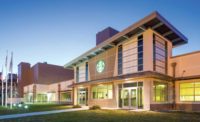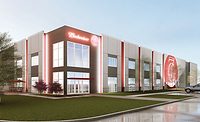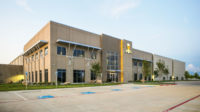Facility planning maximizes space, efficiency






According to Bill Leber, director of business development for Buchs, Switzerland-based Swisslog, “Capital decisions cast long shadows.” In other words, when a company is investing millions of dollars into a manufacturing or warehouse facility, it needs to make sure it’s making the right decisions because they will impact the business for years to come, he says. Therefore, it’s important to select equipment, plant layouts and facilities that not only can stand the test of time but also can keep up with industry trends.
One of the biggest trends beverage-makers are experiencing is SKU proliferation, experts say. Typically, companies turn to facility planners when they have run out of space, says Jack Holleran, president of HDA Architects LLC, St. Louis.
David Wittliff, partner with Concord, N.H.-based Design Group Facility Solutions Inc. (DGFS), a subsidiary of Barry-Wehmiller Design Group Inc., agrees, noting: “In distribution centers, the weakness and inefficiency has largely been driven by the proliferation of SKU counts and the need to hold inventory levels sufficiently high enough to support sales requirements while balancing lags in the manufacturing supply chain. … It’s the lower volume, higher margin items that many facilities struggle with accommodating. The result is low case pick rates per man-hour of labor, out of stocks, long pick path travel distances and the need to replenish pick faces during the case selection period, which is operationally inefficient and a safety hazard.”
Solutions for these warehouse inefficiencies vary from changing rack types to installing case flow racks for an increased number of pick faces to adopting automated or semi-automated case selection, Wittliff says.
For instance, Swisslog utilized the vertical space in Coca-Cola Amatil’s facility in Australia and installed a crane-fed automated storage and retrieval system (AS/RS) to increase storage capacity. It also installed a monorail linking the receiving, storage and staging operations to transport as many as 740 pallets an hour from any source to any destination within the system. Lastly, it designed staging areas to provide operational flexibility during peak and non-peak periods. These areas also enable the loading of trailers while the system automatically stages the next load. Between the facility’s six docks, more than 15 trailers can be loaded every hour, which equates to one 22-pallet trailer every four minutes, Swisslog states. In the end, Coca-Cola Amatil was able to consolidate its warehousing operations, improve efficiency and incorporate environmental initiatives, it adds.
Tackling challenges
Additionally, DGFS’s Wittliff and HDA Architects’ Holleran note that the trend toward moving from side-bay trucks to conventional box trucks has created a challenge for facilities.
“The fleet in many locations is rapidly changing from side-bay trucks to more conventional end-loader trucks,” Holleran says. “That means they need dock positions that they don’t have and [have] side-bay drive-throughs that they don’t need or need very little of; so we find opportunities to expand office, ancillary space or warehouse into obsolete spaces and add dock positions to increase productivity within the existing building.”
The consolidation of sales centers into one location also results in more routes being run from one location, which equates to more trucks, more points of sale, more cooler and draft service, and the need to manage more associates at one location, DGFS’s Wittliff adds. These are all issues that most older facilities are not prepared to deal with, he says.
Likewise, weakness and inefficiency often is driven by facility age and unplanned, incremental growth in manufacturing plants, Wittliff says.
“The processing and packaging technologies that were used several decades ago to lay out a facility are irrelevant given the evolutionary changes that drive modern plants,” he says. “Frequently, these older plants are not adaptive to more complex process systems, which demand a larger complement of raw materials and segregated hygiene zones and cannot accommodate the large space requirements that the multiple secondary packaging configurations require. The result is plants that are a hodgepodge of sanitary compromises for path of travel, HVAC systems and hygiene zones that is difficult to correct. On the packaging side, the line layouts are forced to fit to building configuration, resulting in less than optimal approaches to machine centers, difficult access and the intrusion of the packaging lines into what was once warehouse space.”
According to Lloyd Snyder, senior vice president at Portland, Maine-based Woodard & Curran, equipment automation reliability and facility selection are two major issues that companies often face. For instance, older facilities with older equipment might need better automation to help control the flow of the process. Or, facilities might need to rebuild some new equipment to fix part of their process or better train their operators to help them manage the process, he explains. When it comes to facility selection, sometimes buildings are chosen that weren’t properly designed for beverage production, and issues can arise once manufacturing begins, he adds.
“We have to start thinking about the food safety issues — things like hygiene zones and ventilation [and] drains,” Snyder says. “How do you make sure operators are going from one area to the other area safely and not tracking in contamination? Those are just some of the different things that we have to think about.”
According to DGFS’s Wittliff, making adjustments to the facility layout or mechanical systems to improve sanitation practices has been receiving greater attention in the last few years as more manufacturers work on reducing product risk.
But above all else, companies should focus on water issues at a beverage facility, Woodard & Curran’s Snyder says. Water and wastewater are such large components of beverage production that it’s vital to understand the source of the water and the treatment of the water, he explains.
“We really focus on the water issues at a beverage facility more than anything else, and we also focus a lot on the wastewater because a lot of clients don’t understand — things go down the drain, and they don’t really understand the requirements, the regulations, and they get in trouble with regulators sometimes dealing with the wastewater, so we’ll often have to help them understand and treat their wastewater better and [understand] how to meet regulations,” Snyder says.
Green options
Furthermore, the way a facility handles water can help it to become more sustainable. For instance, Woodard & Curran worked with a client whose production was limited because there was a restriction on the amount of water it could draw from the city. To increase production and maximize its water supply, the facility started treating its used water and reusing it in non-potable areas such as cooling towers, Snyder says.
Facilities also can optimize their energy usage by putting heat pumps on variable frequency drives and using a thermal recovery system to help reuse energy, for example, he says. This is particularly important for beverage facilities with injection and blow molding operations, which use a lot of energy, he adds.
There are many opportunities for heat recovery and to rebalance the thermal energy needs that were unable to be implemented in the past because the technology did not exist, DGFS’s Wittliff says. Now, with better controlled automation, industrial heat pumps, heat transfer and storage technologies, new plants can reduce both consumption and emissions, he says.
Most high-bay warehouses also offer recoop-eration, which basically generates electricity by reclaiming energy from equipment, Swisslog’s Leber says. With that, high-bay warehouses tend to have a smaller footprint because they require less land and fewer employees, which can make things more efficient, he adds.
“With agencies such as the [Environmental Protection Agency] (EPA) placing stronger scrutiny on public utilities and what they are discharging into rivers and other water sources, sustainability is no longer just about being earth friendly; it’s a business requirement,” says Chris Harmon, senior vice president and project manager for Hixson Architecture & Engineering, Cincinnati. One such way to be more sustainable while saving money is by checking for compressed air and steam leaks, he notes.
“Compressed air leaks can be costly regardless of whether they are from piping pinholes, tubing kinks, excessive bleed-off from air-actuated valves, faulty solenoids, old or faulty gaskets, poorly seated connections or threaded fittings, or a dozen other sources,” Harmon says. “A one-thirty-second-inch hole, for example, can lose 0.81 standard cubic feet per minute, wasting more than $150 per year in electricity costs. While not much by itself, the cost of leaks can add up quickly: With 80 of these pinholes — which is not many for a typical plant — the cost of the wasted energy jumps to more than $12,000 per year.”
Likewise, a one-thirty-second-inch hole in a 125 psig steam line will leak about 4 pounds of steam an hour, wasting approximately $300 a year in natural gas, he adds.
Additionally, HDA Architects’ Holleran says it models a facility’s insulation and air infiltration of roof, walls, docks, shelters, levelers, HVAC and lighting, which can all help to reduce energy consumption. The firm recently finished work on Del Papa Distributing’s facility in Texas City, Texas, which now includes many energy-efficient, sustainable features.
“We have light-emitting diode (LED) lighting in the parking lot and LED lighting and motion sensors in the office,” Holleran explains. “We also have high-bay florescent fixtures with motion sensors in the warehouse. We have warehouse clear heights to accommodate four pallet high to optimize the cubic area in the future. We have vertical dock levelers so the exterior dock doors close tightly to the floor and we eliminate leakage of cooling or thermal gain from the outside into the space. We’ve used the big fans that are high volume and low speed fans; they’re very energy efficient and they move a lot of air. They make the space very comfortable and really help us offset some of the HVAC requirements. And we’ve used the sandwich insulated concrete tiltwall system; calculations on the wall really give us a high R value. We then tie the wall insulation to the roof to create a real thermal efficient envelope so their energy costs are as low as we can make them.” BI
Tips for optimizing operations
According to Chris Harmon, senior vice president and project manager for Hixson Architecture & Engineering, Cincinnati, there are five ideas that food and beverage facilities should consider when it comes to optimizing operations:
1. Use continuous processing systems versus batch systems. Whereas capacity is king with a batch system — you run as much product as your systems (production through distribution) can handle — with a continuous system, the product run is determined by demand. Products in higher demand will run longer than those in lesser demand. The key factor here is reducing the need for changeovers, which slow down the operation.
2. Synchronize the supply chain with sales so that plants are only producing enough product needed to replenish with some limited production buffer. In this scenario, inventories are limited, and re-work and equipment changeovers are kept to a minimum. Keep in mind, this requires a highly functional production planning system that feeds production data requirements to the plant on a daily basis.
3. Implement performance measurement, such as overall equipment effectiveness (OEE). OEE is a series of data, which, when combined together, indicates the success of a plant’s operation. Improving OEE requires efforts such as eliminating the unevenness in production line flow, having extended production runs and reducing changeover times.
4. Increase line flexibility via the downstream packaging equipment. This will enable you to build single pallets or rainbow pallets — whatever configuration is required.
5. Employ a staff capable of dealing with higher technology systems. This might require a change in tactics toward hiring, as well as retention and training programs, but will, in the end, lead to improvements. BI
Looking for a reprint of this article?
From high-res PDFs to custom plaques, order your copy today!









